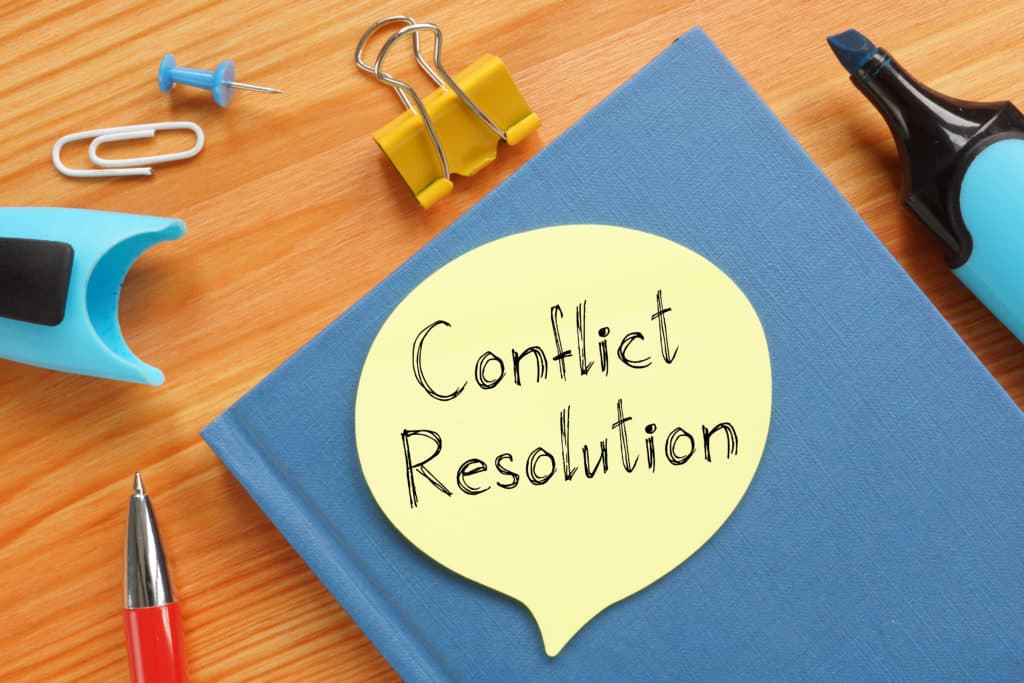“Don’t fear conflict; embrace it – it’s part of your job.” —Clara Sayrol

When a group of people comes together, conflict can arise and may become integrated into any part of a social and organizational setting. This is no different at work.
The most common instigators of business conflicts have two root causes: poor communication and the inability to control one’s emotions.
Conflict can start with a simple disagreement and often escalate into an argument that impedes the productivity of a team and decreases employee morale. Therefore, it is important to be able to recognize conflicts early on and address them swiftly before they escalate.
One of the most important skills for leaders today is conflict resolution. Strong conflict resolution skills equal strong employee retention. Leaders that are not able to deal with conflict effectively will eventually watch their best talent walk out of the door in search of a healthier, more collaborative work environment
1. Understand Conflict as an Opportunity: Embrace it
Pick your battles carefully and avoid conflict for the sake of conflict. However, if the issue is big enough to create a problem and impede business productivity, then it is certainly relevant enough to be addressed. Perhaps one of the most important steps to take is to actively decide to acknowledge and engage in a conflict resolution strategy and recognize that there is a mismatch of interests. Without embracing a conflict, a business cannot solve it.
Conflict can be a good thing. It can highlight where issues lie in your business and present a valuable opportunity for your employees to grow and become better as a team. Conflicts can also improve interdepartmental communication. If a conflict develops between two teams, it’s a good time to improve interdepartmental cooperation at the same time as developing the employee’s personal communication and empathy skills.
Whenever conflict does not come to the surface to be resolved, resentment grows, and the next conflict around that person, issue or project will carry the weight of the original unresolved conflict and become increasingly intractable.
2. Communication and understanding are key: Listen carefully and talk together
The only way to solve conflict is to communicate. Ask your disputed employees to set up a meeting. After setting up the appropriate environment to talk about the conflict, remember to moderate the meeting so that every person in the room has the same amount of time, an appropriate space to say and explain what he or she considers the other one needs to hear, without being interrupted.
It is important to create an environment where everyone feels included and their opinions are valued, so try to set up a pleasant, impartial environment where everyone feels comfortable and heard. Do not allow any individual to monopolize the conversation. If one participant is feeling disadvantaged and is not able to express how he or she sees the situation, the conversation will lead to a negative outcome. It is helpful to set some ground rules; focus on the issue at hand, and not to go off course.
Help your employees focus on solving the problem, not attacking each other, or assigning blame. Accusing and blaming someone’s past actions is not going to lead to any productive solutions. All participants in the meeting must actively listen, no telephones or other distractions. Listening helps each employee to understand the other person’s perspective. Have the feuding employees ask follow-up questions to help illuminate what each employee is saying. One employee can rephrase what an employee said to make they understand the other. For example, you can say something like, “Because of…you feel …., is that right?” This allows the other employee to clarify any details and misunderstandings.
3. Find Agreement
Since a common tendency in human nature is to monopolize attention as much as possible, the conversation may tend to focus on disagreements or complaints rather than on shared points of agreement. Employees should search for points of consensus. Agreeing on specific points generates positivity, which could help break down the conflict. Agreement can give the employees a common base, from which to rebuild their relationship.
If the employees cannot identify common ground, you can point out any common points the employees talked about, however small. Show them that they do have commonalities to help consolidate and pull them together.
For example, if an individual disagrees on a specific communication practice, a clear explanation can be provided. Then the other individual can acknowledge this explanation, in that he or she is then able to see and understand the motivation behind the taken actions given circumstances. This will help both individuals lay the foundations to rebuild a healthier, more trusting relationship.
By the finalization of the meeting, the experience should always emerge with more positives than negatives.
Looking for agreement demonstrates the employee’s willingness to seek out common ground and build a relationship around those trust elements.
4. Forgive because no one is perfect
Every conflict, being in a private or business environment, aims for a clear outcome that acknowledges all hurt feelings and identifies a solution to start fixing them.
Employees should be willing to apologize. Tell the other person you’re sorry for any bad words or actions and be sincere about it. It is your responsibility also to forgive the other person. Agreeing solely for the sake of internal appearances at work can lead to bigger grudges that deepen over time, undoing any progress achieved during the conversation.
5. Provide Guidance
When you help employees work through a conflict, it is important to stay objective and remember that you are there to help the employees work through their issue, no less and no more.
Guide the conversation and keep it focused. Give your employees advice on what they should do next. You can apply lessons learned in your business procedures to help manage future conflicts.
While conflicts in the office cannot always be prevented, the key element in successful conflict resolution is addressing them before they escalate, where possible.
While companies can not always prevent conflicts in the office, the key factor to conflict resolution is, in fact, preventing them where possible. By recognizing and proactively intervening in proper time, conflicts can be solved even before they arise.
Author: Clara Sayrol Life Science consultant KVALITO
KVALITO is a strategic partner and global quality and compliance services and network for regulated industries.
If you would like to benefit from KVALITO’s expert services, please send us an email to client.partner@kvalito.ch. Are you looking for an exciting and challenging position as a consultant? Please send your complete application to recruiting@kvalito.ch



